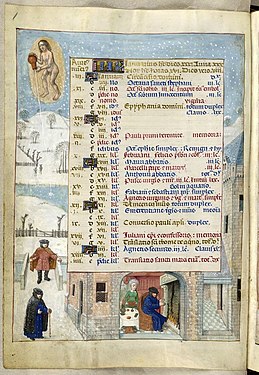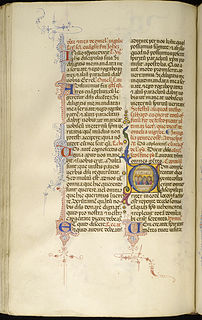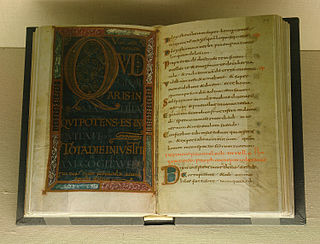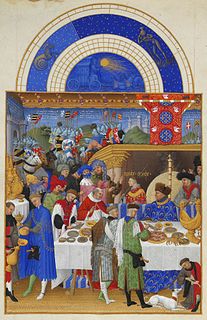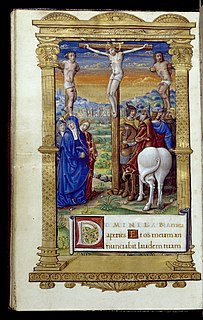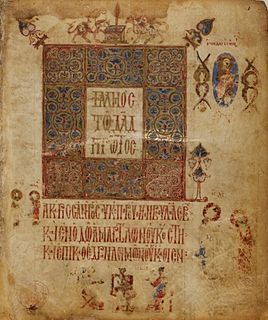| Folio | Date | H [n 18] | Typ [n 19] | Description |
|---|
| f293r | 30/11 | 24 | PW | Andrew, apostle and his death on the cross. In the background a story about Andrew from the Golden Legend by Jacobus de Voragine is depicted. |
| f297r | 4/12 | 24 | PW | Saint Barbara seated in a closed garden next to her icon, the tower. In the landscape in the background her life and martyrdom are depicted. |
| f297v | 6/12 | 9 | I | Saint Nicholas, the initial was never historiated and remained empty. |
| f301r | 8/12 | 12 | CW | Coronation of the Virgin by the Trinity |
| f303r | 13/12 | 7 | I | Lucia van Syracuse with a book and a column [n 20] |
| f304v | 21/12 | 9 | I | Thomas the Apostle, With a spear as attribute. [n 21] |
| f306r | 26/12 | 9 | I | Saint Stephen, the first martyr, with book and stones (he was stoned to death). |
| f309r | 27/12 | 24 | PW | John the Evangelist on Patmos. He is pictured with his symbol, the eagle, writing on a scroll. In the landscape in the background one can see three of the four horsemen of the Apocalypse . |
| f312r | 28/12 | 12 | CW | The Innocent Children, with a picture of the Infanticide of Bethlehem. |
| f314v | 29/12 | 12 | CW | Thomas Becket; Thomas stands at the altar with his chaplain, while behind him his murderers approach. |
| f320v | 17/1 | 9 | I | Anthony of Egypt, abbot and hermit, in a black robe with a staff and a book bag. |
| f322v | 20/1 | 9 | I | Fabian en Saint Sebastian. Fabian as a bishop with his staff and Sebastian fixed to a pillar and pierced with arrows. Besides their common feast date, there is no relation between these saints. |
| f324r | 21/1 | 10 | I | Agnes, standing in a landscape with a lamb, her attribute based on her name (agnus = lamb). The palm branch she holds is the symbol of her martyrdom. |
| f326r | 22/1 | 12 | I | Vincent of Saragossa with palm branch and book in his hands. |
| f328v | 25/1 | 13 | CW | Conversion of Paul the Apostle. Paul falls with his horse and in the air, we see his vision of Christ. |
| f331v | 28/1 | 15 | CW | De Translation of Thomas Aquinas. Thomas is depicted in a garden holding a chalice while his staff and mitre lay on the ground. He is crowned by an angel. Staff and mitre are erroneous attributes, Thomas was not a bishop. |
| f337v | 2/2 | 24 | PW | Purification of the Virgin or the Presentation of Jesus at the Temple, also called Candlemas. |
| f345v | 22/2 | 14 | CW | Chair of Saint Peter. Christ speaks to Peter kneeling with Tiara, with in the background the chair of Peter. |
| f347r | 24/2 | 14 | CW | Matthew the Apostle. Matthew is depicted in a landscape with a book and a try square. He is usually depicted with a spear or halberd, believed to be the tool of his martyrdom, but here the artist preferred to the square, his symbol as Patron Saint of the carpenters.. |
| f348r | 8/3 | 24 | PW | Thomas Aquinas and the miracle of the speaking Crucifix. |
| f354r | 25/3 | 24 | PW | Annunciation. The miniature shows the annunciation with the traditional iconography but with a Tree of Jesse in the background. This combination is quite rare but can be explained by the text of Isaiah (11:1): “And there shall come forth a rod out of the root of Jesse”, that is added to the lessons for Matins in the Dominican breviary. |
| f358r | 5/4 | 14 | CW | Vincent Ferrer, a Dominican looking up to a vision of Christ in the sky.. |
| f363r [n 22] | 23/4 | 12 | CW | Saint George fighting the dragon. The princess he was rescuing is kneeling in the background. |
| f364r [n 22] | 25/4 | 10 | CW | Mark the Evangelist writing in a room in the company of a lion, his symbol. |
| f365r [n 23] | 29/4 | 24 | PW | Peter of Verona The miniature shows a Dominican kneeling, with a dagger in his side and writing “Credo” with his blood on the ground. |
| f367r [n 22] | 1/5 | 12 | CW | Philip and James the Less, apostles. They are depicted in a landscape. Philip is holding a cross-staff while James holds a fuller’s club, the tool of his martyrdom. |
| f368r [n 22] | 2/5 | 24 | PW | Catherine of Siena, was a tertiary of the Dominican Order. She is depicted with a crucifix and flowers in her right hand and a heart in her left. Catherine is crowned with a crown of thorns. |
| f372r [n 23] | 3/5 | 12 | CW | The Invention of the Cross by Saint Helena, the mother of Constantine the Great. The scene shows Helena looking at a man digging with a pick-axe. |
| f374r [n 23] | 4/5 | 13 | CW | Feast of the crown of thorns. The miniature shows a seated Christ being crowned with thorns. |
| f385v [n 22] | 22/6 | 12 | CW | Saint Acacius and the Ten thousand martyrs. The miniature depicts a number of corpses on thorn bushes at the foot of a hill. |
| f386v [n 23] | 24/6 | 24 | PW | Nativity of John the Baptist. The miniature shows the room where John was born. The midwife and her assistant are preparing a bath for the baby and Zacharias, in the left foreground, is writing the name of the newborn in a book (Luke, 1:57-64). |
| f390r [n 23] | 26/6 | 12 | CW | John and Paul, martyrs. John and Paul were beheaded in Rome under Julian the Apostate (361-3). It is clear that the artist had no example of iconography to use, for he depicts John as John the Baptist holding a lamb and the apostle Paul holding a sword. |
| f392r [n 23] | 29/6 | 24 | PW | Peter and Paul, apostles. The miniature shows the two apostles being beheaded, what is correct for Paul but Peter was crucified according to the tradition. |
| f399r [n 23] | 2/7 | 24 | PW | Visitation. This miniature was painted around 1500, probably by a Spanish artist. The building on the right is in a classical style, not used by the Flemish painters. |
| f404v | 10/7 | 14 | CW | The Seven Brothers, the seven sons of Felicitas of Rome. |
| f405r | 11/7 | 13 | CW | Saint Procopius. He is depicted as an abbot holding a book and his crosier. His mitre is placed on the altar to the right. Procopius founded the abbey of Sázava in Bohemia. He is one of the Saints added to the calendar and the sanctoral by the Dominicans to “internationalise” the list of saints. This is also the case with Louis IX, Wenceslaus of Bohemia and Edward the Confessor. [m 6] |
| f405v | 17/7 | 12 | CW | Alexius of Rome, depicted holding an open book and a sceptre and a ladder beside him. |
| f406v | 20/7 | 9 | CW | Margaret of Antioch. Margaret steps out of the dragon with a crucifix in her hands. |
| f407v | 21/7 | 14 | CW | Praxedes holding a palm and a book. Roman martyr, second century. |
| f408r | 22/7 | 12 | CW | Mary Magdalene depicted in a landscape with mount Calvary and holding an ointment jar, her attribute. |
| f411r | 23/7 | 13 | CW | Apollinaris of Ravenna as bishop, reading a book and holding crosier and sword. |
| f412v | 25/7 | 15 | CW | James the Great, reading a book and holding a pilgrim’ staff. A scallop shell is fixed on his hat. |
| f414r | 26/7 | 14 | CW | Virgin and Child with Saint Anne, a very popular depiction in Flanders. |
| f417r | 27/7 | 15 | CW | Martha reading a book and holding keys and a ladle, illustrating her attention with domestic affairs.. |
| f418r | 29/7 | 15 | CW | Felix, Simplicius, Faustinus and Beatrix Roman martyrs. Nearly nothing is known about the Roman martyr Felix who was confused with Antipope Felix II. In the miniature he is presented as a pope. Either Simplicius or Faustinus is represented as a bishop. This is also an error for both of them were laymen. Beatrix was the sister of Simplicius and Faustinus and died also as a martyr. There is no relation between Felix and the others except for the fact that their feast days are on the same day, July 29. |
| f419v | 1/8 | 14 | CW | The Liberation of Saint Peter from jail by an angel, according to the Acts 12. |
| f421v | 3/8 | 14 | CW | Inventio [n 24] van Saint Stephen. He is represented as a deacon in a dalmatic with two stones on his head. In the left hand he holds a book ant with the right hand he holds up his dalmatic filled with stones. Stephen was the first martyr and was stoned to death. |
| f423v | 5/8 | 14 | CW | Saint Dominic, The founder of the Dominican Order. He is depicted in a landscape with a dog holding a flaming brand to his left and a daemon head at his right. It is astonishing that he got only a small miniature in a breviary for Dominican use. |
| f427r | 6/8 | 14 | CW | The Transfiguration of Jesus on Mount Tabor (Matthew 17:4-5) |
| f431r | 10/8 | 14 | CW | Lawrence of Rome. The miniature shows Lawrence as a deacon holding a book and a gridiron. He was martyred by burning on a gridiron. |
| f437r | 15/8 | 18 | PW | Assumption of Mary. The miniature shows the crowning of the Virgin Mary by the Trinity. Around the throne are music-playing angels. This theme is not the normal theme used for the illustration of the assumption. In contemporary Flemish breviaries this feast is illustrated by either de dead of the Virgin or by the Virgin carried up to heaven by angels. In the border under the miniature, the Arms of Francesco de Rojas were painted. On the opposite page there is a full page miniature with the arms of Ferdinand and Isabella and those of the two couples that were going to be married. |
| f441r | 20/8 | 15 | CW | Bernard of Clairvaux with book and crosier and dressed in a Cistercian habit. Beside Bernard are a dog and a chained devil. |
| f442v | 24/8 | 16 | CW | Bartholomew. Depicted in a landscape, holding a knife and a book bag. His attribute the knife, was the tool of his martyrdom, he was flayed alive. |
| f444r | 25/8 | 14 | CW | Saint Louis, king of France. |
| f445v | 28/8 | 13 | CW | Augustine seated as a bishop, with a heart in his right hand and a crosier in the other. |
| f449r | 29/8 | 16 | CW | Beheading of St. John the Baptist situated in a landscape. John points to the Lamb of God sitting on a book and holding a crucifix. Normally one should find a miniature of Salome receiving the head of John, it seems that the miniaturist choose the wrong theme. |
| f451v | 8/9 | 19 | CW | The birth of Mary. One can see a midwife presenting the baby to Anne and Joachim, who is kneeling in the foreground. |
| f455r | 9&11/9 | 17 | PW | Gorgonius, Protus and Hyacinth. The page-wide miniature is divided in two by a column. The left half depicts Gorgonius standing before a wall with a sword in his hands, behind the wall we see Protus and Hyacinth holding a book. In the other half, the feast of the Exaltation of the Cross is illustrated. Emperor Heraclius is depicted, bare footed, porting the cross through the gate of Jerusalem. |
| f458r | 16/9 | 15 | CW | Euphemia with a sword and a millstone. Euphemia was the daughter of a Roman senator and was martyred under the reign of Diocletian. |
| f459r | 21/9 | 16 | CW | Matthew the Apostle the evangelist with his symbol, the angle, writing at a desk in his study. |
| f461r | 22/9 | 13 | CW | Saint Maurice and his companions. Maurice is depicted in armour, holding a sword and reading a book. Four of his companions are standing at his side. |
| f462r | 27/9 | 12 | CW | Cosmas and Damian were twin brothers and physicians according to Christian tradition. They are depicted, one with a urine bottle in his hand, the other with a mortar and pestle. |
| f463v | 28/9 | 15 | CW | Saint Wenceslaus, duke of Bohemia depicted with sword and book before a landscape. |
| f464r | 29/9 | 15 | CW | Archangel Michael in armour with a sword, fighting a dragon and trampling a demon. |
| f476v | 30/9 | 12 | CW | Jerome dressed as a cardinal sitting in a landscape with a lion. |
| f468v | 1/10 | 16 | CW | Remigius of Reims depicted as Saint Bavo. He is depicted as a knight on a horse holding sword and shield. |
| f469v | 4/10 | 15 | CW | Francis of Assisi receiving the stigmata. |
| f470v | 7/10 | 14 | CW | Pope Mark with tiara and crosier, reading a book. |
| f471r | 9/10 | 15 | CW | Denis and his companions Eleuterus and Rusticus. He stands in a landscape with a chapel in the background and is head is half decapitated. In the iconography of St Denis he is often represented walking and carrying his own head after he was decapitated. |
| f472v | 13/10 | 13 | CW | Translation of Edward the Confessor with sceptre and an open book in front of a cloth of honour. |
| f473r | 18/10 | 13 | CW | Luke the Evangelist in his study working on a painting of the Holy Virgin. Is symbol, the bull or the oxen is also depicted. |
| f474v | 21/10 | 16 | CW | Saint Ursula and the eleven thousand virgins. They are depicted in a landscape with Ursula flanked by two of her companions in front of a procession of virgins. Ursula is holding arrows in her hands. |
| f467r | 28/10 | 16 | CW | Simon the Zealot or Simon the apostle and Jude the Apostle. Simon, patron of the carpenters is holding a saw and Jude is reading a book. |
| f477v | 1/11 | 19 | PW | All Saints' Day. The miniature shows the Trinity, Father and Son enthroned and the Holy Ghost in the form of a dove hovering above them. Below the throne we see Mary flanked by two female saints and surrounded by a large crowd of saints, both clergy and laity. |
| f481r | 2/11 | 19 | PW | All Souls' Day. The raising of Lazarus is depicted on the miniature. This is a quite unusual theme for All Souls' Day in Flemish art. |
| f484v | 8/11 | 14 | CW | Four Crowned Martyrs. The martyrs represented on the miniature are Claudius, Nicostratus, Simpronianus and Castoris, four stonemasons who were martyred in Rome in the early fourth century. They are holding the tools of their trade like trowel, hammer, chisels, a set square and a large wooden plank. One of them is holding a book. |
| f485r | 9/11 | 16 | CW | Theodore of Amasea, also known as Theodore Tiro. He is represented as a richly dressed lay person, but in fact he was a soldier and should have been depicted as such. |
| f485v | 11/11 | 15 | CW | Martin of Tours, dividing his cloak to share it with a naked cripple at the gate of the city. |
| f488v | 19/11 | 16 | CW | Elizabeth of Hungary. She is depicted standing before a cloth of honour carrying two crowns. One as a symbol of her worldly status and the other to symbolize her sanctity. |
| f491v | 22/11 | 17 | CW | Saint Cecilia, depicted in a niche. She is reading a book while holding a portative organ in her arm. Cecilia is the patron of musicians. |
| f494r | 23/11 | 17 | CW | Pope Clement I. The miniature depicts Clement in a landscape with a ship on the sea in the background. He wears a tiara and holds a processional cross, a big anchor is lying behind him. He was martyred by throwing him in the sea with an anchor tied to his neck. |
| f495v | 25/11 | 17 | CW | Catherine of Alexandria. She is depicted standing in a landscape holding a sword and a book. In the background one can see the broken wheel. She is trampling emperor Maxentius, her crowned persecutor, who holds a sceptre in his hand. This iconography was popular in Flanders. [a 10] |
|



